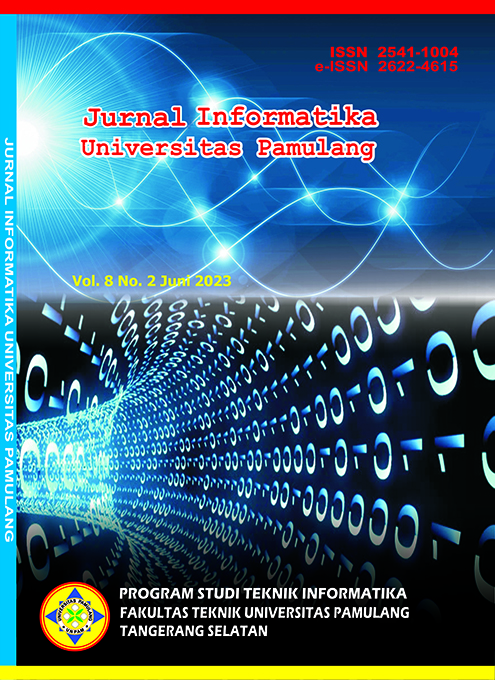Implementasi ERP sebagai Pengintegrasi Sumber Daya Perusahaan pada PT. KSteel Nusantara
DOI:
https://doi.org/10.32493/informatika.v8i2.32413Keywords:
ERP, Integration, Modul, Sales, WarehouseAbstract
PT KSteel Nusantara is a fabrication company and distributor of building materials which in practice still uses manual recording and has not maximally utilized the development of integrated information technology, especially in the field of sales and warehouse. So that there are several problems such as the length of time recording, prone to data loss and not yet integrated between these two fields. This study aims to implement the Warehouse Management module and the Sales Management module in an integrated information system based on Enterprise Resource Planning (ERP) at PT KSteel Nusantara. In this study using data collection methods that include interviews, literature studies, and observations. Then for system design using a visual modeling method, namely UML (Unified Modeling Language) which contains Use Case Diagrams, Activity Diagrams, Sequence Diagrams and Class Diagrams and uses the Waterfall system development method. The results of the implementation of the Warehouse Management module and the Sales Management module based on Enterprise Resource Planning (ERP) show an increase in operational efficiency through better integration between the sales and warehouse fields, as well as optimization of data management in business processes.
References
Alfina, O., & Harahap, F. (2019). Pemodelan UML Sistem Pendukung Keputusan Dalam Penentuan Kelas Siswa Siswa Tunagrahita. METHOMIKA: Jurnal Manajemen Informatika & Komputerisasi Akuntansi, 3(2), 143-150.
Aziza, S., & Rahayu, G. H. N. N. (2019). Implementasi sistem enterprise resource planning berbasis Odoo modul sales dengan metode RAD pada PT XYZ. Journal Industrial Servicess, 5(1), 49-57.
Batubara, M. Z., & Putri, R. A. (2021). ZISWAHIB Processing Website Design (Zakat, Infaq, Alms, Waqf, Grants) at the North Sumatra Branch of Orphans House Using the Bootstrap Framework V.5.1.3. International Conference on Sciences Development and Technology, 1(1), 78-83.
Fathi, Z. M., Ridwan, A. Y., & Saputra, M. (2019). Perancangan Sistem Erp Manajemen Rantai Pasok Halal Untuk Industri Makanan Modul Sales Management Dengan Metode Asap (studi Kasus: Vannisa Brownies). eProceedings of Engineering, 6(2) 8264-8274.
Fatmawati, T., Kramanandita, R., & Miza, R. (2022). Rancangan Implementasi Enterprise Resource Planning (ERP) pada Sistem Pengelolaan Sales Order PT Jaya Mandiri Indotech. Jurnal Teknologi Dan Manajemen, 20(1), 33-44.
Hapsari, D. P. (2019). Pengaruh Enterprise Resource Planning terhadap Kinerja Keuangan Perusahaan. Owner : Riset Dan Jurnal Akuntansi, 3(2), 108-116.
Manik, D. A., & Sari, P. I. (2020). Penggunaan Analisis Swot Dalam Mengembangkan Keterampilan Dan Potensi Usaha Dodol Nanas Kecamatan Sungai Gelam Muaro Jambi. SJEE : Scientific Journals of Economic Education, 4(1), 13-24.
Putri, I. G. A. P. A., & Nurcaya, I. N. (2019). Penerapan Warehouse Management System Pada Pt Uniplastindo Interbuana Bali. E-Jurnal Manajemen Universitas Udayana, 8(12), 7216-7238.
Radhila, A. (2018). Implementasi Warehouse Management Menggunakan Metode Pdca Studi Kasus Di CV. Innotech Solution - Malang. Jurnal Valtech, 1(1), 230-241.
Ramadanti, E. C. (2020). Integrasi Nilai-Nilai Islam Dalam Pembelajaran IPA. Jurnal Tawadhu, 4(1), 1053-1062.
Rosad, A. M. (2019). Implementasi Pendidikan Karakter Melalui Managemen Sekolah. Tarbawi: Jurnal Keilmuan Manajemen Pendidikan, 5(02), 173-190.
Sambiu, I. H., & Amir, Y. (2018). Sistem Informasi Pesediaan Obat Pada Puskesmas Kalumata Berbasis Web. Jurnal Ilmiah ILKOMINFO - Ilmu Komputer & Informatika, 1(1), 10-19.
Samsudin, S., Irawan, M. D., & Harahap, A. H. (2019). Mobile App Education Gangguan Pencernaan Manusia Berbasis Multimedia Menggunakan Adobe Animate CC. (JurTI) Jurnal Teknologi Informasi, 3(2), 141-148.
Suendri, S., Triase, T., & Afzalena, S. (2021). Implementasi Metode Job Order Costing Pada Sistem Informasi Produksi Berbasis Web. JS (Jurnal Sekolah), 4(2), 97-106.
Tiana, E., & Prasetyaningrum, E. (2020). Pengembangan Teknologi ERP Modul Customer Relationship Management Studi Kasus Gudang ACC Sampit. Journal of Computer System and Informatics (JoSYC), 1(4), 381-388.
Wijaya, R. A., Qurratu’aini, N. I., & Paramastri, B. (2019). Pentingnya Pengelolaan Inovasi Dalam Era Persaingan. Jurnal Manajemen Dan Bisnis Indonesia, 5(2), 217-227.
Downloads
Published
Issue
Section
License
Authors who publish with this journal agree to the following terms:
- Authors retain copyright and grant the journal right of first publication with the work simultaneously licensed under a Creative Commons Attribution-NonCommercial 4.0 International (CC BY-NC 4.0) that allows others to share the work with an acknowledgement of the work's authorship and initial publication in this journal.
- Authors are able to enter into separate, additional contractual arrangements for the non-exclusive distribution of the journal's published version of the work (e.g., post it to an institutional repository or publish it in a book), with an acknowledgement of its initial publication in this journal.
- Authors are permitted and encouraged to post their work online (e.g., in institutional repositories or on their website) prior to and during the submission process, as it can lead to productive exchanges, as well as earlier and greater citation of published work (See The Effect of Open Access).
Jurnal Informatika Universitas Pamulang have CC-BY-NC or an equivalent license as the optimal license for the publication, distribution, use, and reuse of scholarly work.
In developing strategy and setting priorities, Jurnal Informatika Universitas Pamulang recognize that free access is better than priced access, libre access is better than free access, and libre under CC-BY-NC or the equivalent is better than libre under more restrictive open licenses. We should achieve what we can when we can. We should not delay achieving free in order to achieve libre, and we should not stop with free when we can achieve libre.
Jurnal Informatika Universitas Pamulang is licensed under a Creative Commons Attribution-NonCommercial 4.0 International (CC BY-NC 4.0)
YOU ARE FREE TO:
- Share : copy and redistribute the material in any medium or format
- Adapt : remix, transform, and build upon the material for any purpose, even commercially.
- The licensor cannot revoke these freedoms as long as you follow the license terms





